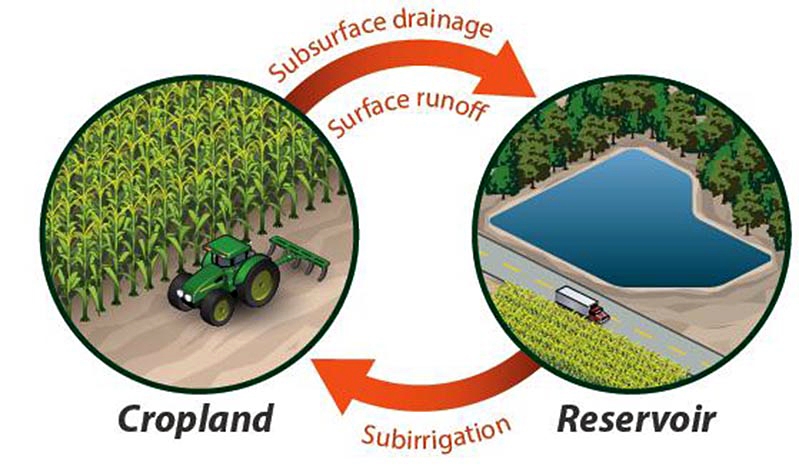
News
Project aims to improve water management on farms
March 20, 2015 By Purdue University
 This "capture and use" system diverts subsurface farmland drainage water into an on-farm reservoir A Purdue University researcher is heading a $5 million federally funded project examining the economic and environmental benefits and costs of storing water on farms in ways for crops to use it when they need it and to reduce nutrients draining into waterways.
This "capture and use" system diverts subsurface farmland drainage water into an on-farm reservoir A Purdue University researcher is heading a $5 million federally funded project examining the economic and environmental benefits and costs of storing water on farms in ways for crops to use it when they need it and to reduce nutrients draining into waterways.March 20, 2015, West Lafayette, IN – A Purdue University researcher is heading a $5 million federally funded project examining the economic and environmental benefits and costs of storing water on farms in ways for crops to use it when they need it and to reduce nutrients draining into waterways.
Jane Frankenberger, professor of agricultural and biological engineering, is directing the five-year research addressing the issues of farm nutrients draining from fields and causing problems downstream, and the need for water in the late summer to irrigate sometimes parched crops.
“Both of these problems are expected to get more pressing with climate change,” Frankenberger said. “This research will collect data now that will help farmers make better decisions in the future.”
The research is funded by the U.S. Department of Agriculture’s National Institute of Food and Agriculture.
Other universities participating in the research project, titled “Managing Water for Increased Resiliency of Drained Agricultural Landscapes,” are Iowa State University, North Dakota State University, Ohio State University, University of Missouri, North Carolina State University, South Dakota State University and the University of Minnesota, as well as the USDA’s Agricultural Research Service.
The objective is to advance three innovative practices that can address the problems of crop loss from increased likelihood of summer drought and the degradation of water quality from drained farmland:
- Drainage water management: Unlike conventional drainage systems, this practice conserves water by increasing its retention time in the soil profile, thereby delaying or reducing the draining of soil water.
- Saturated buffers: These store water within the soil of field buffers by diverting tile water into structures that raise the water table and slow outflow. Early results of a study indicate they can be effective in removing nitrate from tile drain water before it is discharged into surface waters such as streams.
- Reservoirs: With this “capture and use” system, subsurface drainage water is diverted into on-farm reservoirs, or ponds, where it is stored until it is needed to irrigate crops.
The researchers say each of the practices has been evaluated at scattered fields across the region but that findings have not yet been brought together and made into tools to improve decision-making.
Drained lands comprise about 25 per cent of U.S. cropland, some of it among the most productive in the world. Depending on the weather in any given year, fields can get too much water from rain and snow and not enough water, such as from drought. Many scientists believe that such conditions are expected to intensify due to a changing climate.
The project will integrate research, Extension and education to bring new understanding, tools and strategies to increase resiliency of drained agricultural land.
Extension and education programs will extend the strategies and tools to agricultural producers, the drainage industry, watershed managers, agencies and policymakers. They also will help to educate the next generation of engineers and scientists designing drainage systems that include storage in the landscape.
Other Purdue researchers working on the project are Laura Bowling, associate professor of agronomy; Bernard Engel, professor and head of the agricultural and biological engineering department; Eileen Kladivko, professor of agronomy; and Linda Prokopy, associate professor natural resource social science.
Print this page